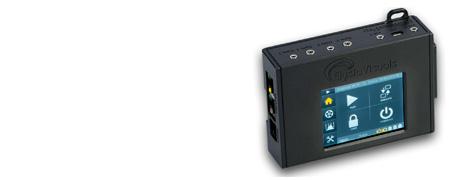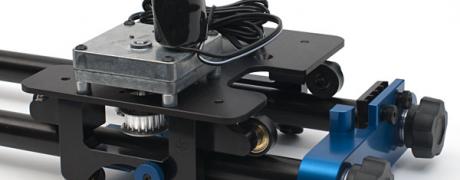Switching between Manual and Bulb exposure
How to use both Bulb exposure and Manual exposure during a shoot
 One of the unique features of the RamperPro is that it can both use manual mode and bulb mode during a ramping shoot. The XMP files of the RamperPro will then smooth out the exposures which results in a smooth and flicker free time lapse movie. In manual mode the RamperPro will use the discrete "normal" shutter speeds of your camera to realize the correct exposures. This means that you can even start with 1/8000th of a second because most cameras support this shutter speed.
One of the unique features of the RamperPro is that it can both use manual mode and bulb mode during a ramping shoot. The XMP files of the RamperPro will then smooth out the exposures which results in a smooth and flicker free time lapse movie. In manual mode the RamperPro will use the discrete "normal" shutter speeds of your camera to realize the correct exposures. This means that you can even start with 1/8000th of a second because most cameras support this shutter speed.
Classic ramping and most other controllers only support bulb exposures. The camera is set to bulb and the controller tries to control the bulb exposure as accurate as, technically, possible. This is all based on the assumption that you can measure the exact exposure time via the PC sync port of the camera. That assumption is pretty close; but not 100% accurate. Shutter lag of the opening and closing shutter greatly influence the accuracy. There is always a very small difference between the bulb exposure and the desired exposure. You will not see this when you only use bulb because the offset will be there for every image.
The RamperPro can switch between manual and bulb exposure. The "minimal bulb speed" setting defines when to use bulb. An exposure longer than "minimal bulb speed" will be made in bulb mode, shorter exposures in manual mode. Not all cameras can be switched between manual/bulb via USB though.
Canon
Most Canon cameras have a dial switch on which bulb is a setting and not an shutter speed in manual mode. The RamperPro cannot switch these cameras between manual and bulb automatically via USB. The RamperPro will show a popup as soon as you need to manually switch the camera to bulb of manual mode. Some Canon cameras, like the 60D, can be switched to bulb mode because bulb is an exposure value in manual mode. The RamperPro will show a notification screen 2 minutes before a manual action is required. That way you are warned in time. This notification is supported in firmware 3045 and higher.
Nikon
All Nikon cameras that are supported by the RamperPro can be switched to bulb mode via USB. Some Nikon cameras have a dial switch that is used to switch between M, A, etc. The RameprPro will ask you to set the camera to manual during the initialization of a shoot.
Panasonic and Sony mirrorless cameras
The RamperPro now supports the mirror less GH4 camera and the Sony A7 series. You cannot use bulb exposure on this camera during a ramping sequence. That is because the electronic shutter of these cameras doesn't work the same as the mechanical shutter of a dSLR. It is not possible to measure the exact bulb exposure speed via a PC Sync port (or a hot shoe). You can still get perfect ramping results with there cameras when you use manual shutter speeds!
Disable the use of Bulb mode
You can choose to disable the usage of Bulb mode. That could be used on Canon cameras so that you don't need to be at your camera when the RamperPro needs a switch from manual to bulb. Another reason could be when you own a mirror less camera like the Panasonic GH4; those cameras cannot be used in bulb in combination with the RamperPro (due to camera limitations). Just set the "Start bulb speed" parameter to a high value like 40 seconds. You will probably never have an exposure time of 40 seconds, thus the RamperPro will never use bulb in this case.
Help, my camera doesn't have a PC sync connection
Some cameras like the Nikon D610 or D750 don't have a PC sync connection. In that case you can get a hot shoe adapter. Another trick can be not to use bulb mode (also in the situation where you forgot to bring one with you).
Why use bulb exposure
The shutter speed is made longer and longer during a sunset shoot. In manual mode this is done by using 1/3 stop discrete steps. So you go from 1/250th of 1/200th of a second. This works fine but sometimes these discrete steps lead to minor over exposures when the 1/3 stop steps are too big. This can be seen as "exposure pumping" when you setup the RamperPro the wrong way. Luckily there are ways to remove this exposure pumping by using free software like: http://davidmilligan.github.io/BridgeRamp/. We advise to set the XMP corrections to be positive when you mostly use manual shutter speeds. That will prevent exposure pumping in your resulting movie!
In bulb mode the exposure steps between shots are very small and that will also result in perfect movies without artifacts like exposure pumping. That is the main reason why you would want to use bulb mode.
Minimal Bulb Speed value
 Some cameras like a Nikon D700 have a long minimal shutter speed in bulb mode. You can check this yourself. Set the camera in bulb mode and press the shutter button as short as possible. Some cameras will then exposure pretty long like 1 second on a Panasonic GH4. Some Canons perform much better in theory. These cameras could support shutter speeds in bulb of around 1/20th of a second. The RameprPro, currently, doesn't support these very fast exposures in bulb mode. This is by-design because we aim to have the most reliable shutter speeds in bulb mode as possible. The second reason is that we want to be able to switch between manual mode and bulb mode without seeing artifacts. The software and RamperPro hardware could support faster exposures in bulb mode but we have chosen to implement for reliability.
Some cameras like a Nikon D700 have a long minimal shutter speed in bulb mode. You can check this yourself. Set the camera in bulb mode and press the shutter button as short as possible. Some cameras will then exposure pretty long like 1 second on a Panasonic GH4. Some Canons perform much better in theory. These cameras could support shutter speeds in bulb of around 1/20th of a second. The RameprPro, currently, doesn't support these very fast exposures in bulb mode. This is by-design because we aim to have the most reliable shutter speeds in bulb mode as possible. The second reason is that we want to be able to switch between manual mode and bulb mode without seeing artifacts. The software and RamperPro hardware could support faster exposures in bulb mode but we have chosen to implement for reliability.
We strongly recommend to use moderate values for minimal bulb speed like 0.3 seconds on the faster Canons or newer Nikons. Slightly older Nikon cameras work great with a minimal bulb speed value of 0.5 seconds. These longer values will ensure a very reliable exposure in bulb mode.
How to get a smooth switch between manual and bulb
The switch between manual and bulb must be a smooth as possible. Otherwise this switch will be visible in your time lapse movie (small flicker). The manual exposures on your camera like 1/100th of a second are very reliable and repeatable. The exposures in bulb are reliable too; but they will have minor deviations. These differences are not seen because of the XMP corrections of the RamperPro.
A switch from lets say 1/20th in manual to bulb mode can be seen as a switch to a pretty fast bulb exposure speed. Any deviation will be seen in the end result. Remember that we are measuring the actual exposure in bulb via the PC sync port and that might very not be the desired shutter speed.
This is the second reason why we recommend to switch to bulb when your exposure reaches values of 0.4 seconds or 0.5 seconds. The difference, in stops, between the accurate 0.5 seconds in manual and the corresponding exposure in bulb is small. That will result in a virtually invisible switch between manual mode and bulb mode!
Conclusion
- Use bulb mode when possible. That way exposure differences between subsequent images will be as small as possible and that will result in smooth time lapse movies without artifacts.
- Set the value of use positive XMP corrections to yes in the system menu when you ramp with normal manual shutter speeds.
- Don't use a small value for minimum bulb speed. A value of 0.5 seconds is safe. This will lead to very reliable exposures in bulb mode and the transitions between manual and bulb mode will be as smooth as possible.
It might be that some camera models, mostly Canons, will work with faster bulb speed settings like 0.2 seconds and not 0.5 seconds. You can easily try this by running a short test sequence. The RamperPro suppports over 30 different camera models and the 0.5 seconds factory default works great on all these cameras.


